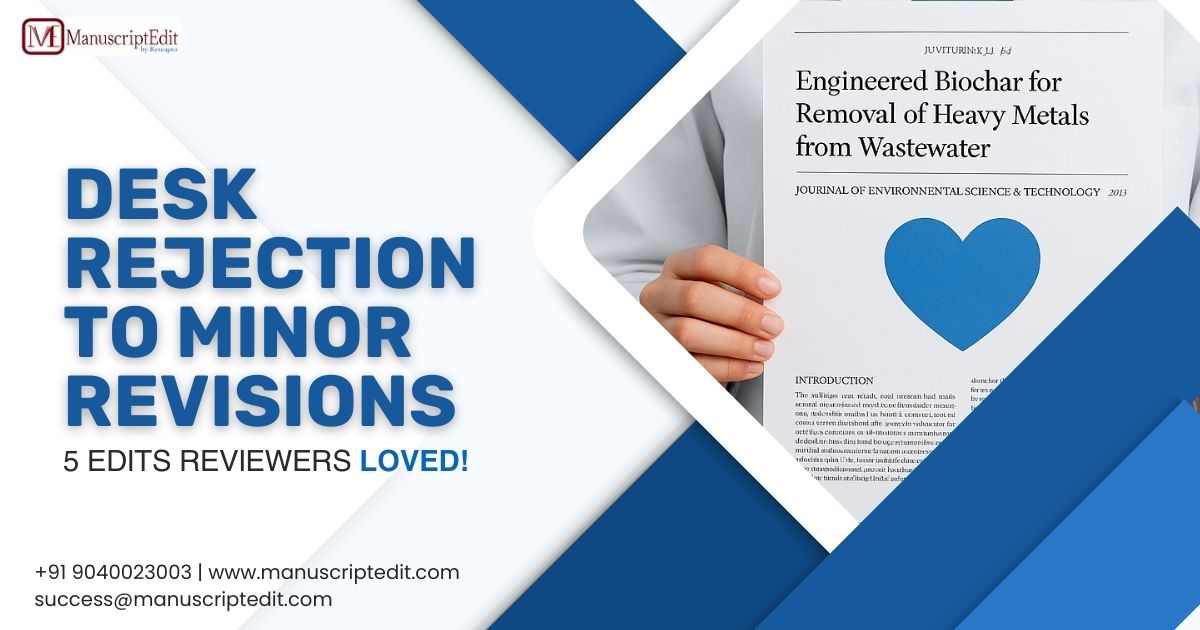Did you know? Between 30% and 70% of manuscripts face desk rejection before peer review. Getting published in a high-impact journal rarely happens on the first submission—most papers follow the classic rinse-and-repeat cycle. In fact, studies show that as many as 62% of published manuscripts have faced at least one rejection before acceptance.
For many researchers, this form of research paper rejection is the most discouraging. Months of experiments, analysis, and writing may result in a one-line rejection letter citing unclear “editorial criteria.”
Yet desk rejection is often caused by fixable issues. Vague titles, weak abstracts, poor figures, or misaligned discussions are among the most common rejection reasons.
This article presents five real before-and-after edits (anonymized) that transformed manuscripts from desk rejection to minor revisions. Each edit demonstrates how addressing specific rejection criteria can help avoid rejection and improve acceptance chances.
Free resource: Desk Rejection Survival Guide — 10 fixes to apply before submission. 📥 Download the Desk Rejection Survival Guide (PDF)
Table of Contents
Why Desk Rejection Happens
Desk rejection ≠ peer review rejection. The rejection criteria at this stage are technical rather than scientific. Common causes include:
- Scope mismatch: As manuscripts lack explicit alignment with the aims of journals, they are desk rejected.
- Lack of novelty: Novel, non-obvious contributions get editorial notice—redundant or old studies don’t.
- Low-quality language or presentation: Even strong results are disqualified if the writing is ineffectual or obscure.
- Inconsistency in formats: Guidelines count—format mismatches can ruin a submission before material is considered on a merits basis.
- Misconduct or plagiarism: Editorial boards strictly reject manuscripts in cases where any misconduct is found.
In short, desk rejection reflects perceived quality and journal fit, not necessarily the validity of results. Understanding these rejection reasons can reduce the risk of article rejection and streamline the publication process.

5 Reviewer-Loved Edits That Made the Difference
1️. Title Clarity Reduced Confusion
Before:
The paper had a generic title: “Study on Water Treatment.” It was flagged by the editor as “too generic” and not for consideration, stating that no novelty or relevance was presented. Such language increases the likelihood of desk rejection, as titles play a determining factor in initial screening.
After:
The new title was: “Engineered Biochar for Removal of Heavy Metals from Wastewater.” This wording expressed specificity, novelty, and journal congruency by including both the studied material and its application.
Reviewer-style comment:
One of the first filters applied by editors is often the title. Generic titles have both scope fit and significance concerns, hence the rejection of papers.
Specific, well-defined titles communicate relevance directly and lower the possibility of desk rejection.
Tip: Compare your title with recent articles in your target journal to ensure precision and scope alignment.
2️. Abstract Strengthened with Clear Objectives
Before:
It was too descriptive in the abstract, had a background, but did not openly outline research aims, and did not offer measurable conclusions. The rejection letter stated: “The abstract lacks clarity and does not highlight the study’s contribution.”
After:
The new abstract contained specific objectives and measurable outcomes: “This study evaluated engineered biochar for wastewater treatment. Results demonstrated a 78% improvement in Pb removal efficiency compared with conventional adsorbents.”
Reviewer-style comment:
Abstracts pave the way for editorial judgments. Without objectives and findings, manuscripts are prone to desk rejection. A brief abstract identifying aims, methods, and major findings is a cue for minimizing scientific contribution and rejection.
Tip: Structure every abstract around three questions—What was done? How was it done? What was found?
3️. Figures Reformatted for Readability
Before:
Low-quality figures were submitted with axis labels missing and data overlaid. Reviewers noted they were only “not interpretable.” Poorly thought-out figures risk harming credibility and allowing rejection of the manuscript.
After:
Figures were converted to high resolution (300 dpi), axis labels were clear, color contrast was present, and the legend was well structured. These improvements made the data presentation accurate and reader-friendly.
Reviewer-style comment:
Images are routinely the first things editors examine. Poor-quality images indicate lack of attention to detail, so they are more likely to get desk-rejected. Neatly formatted figures not only enhance clarity but also instill reviewer confidence.
“Want a free sample edit? Submit your manuscript today.”
4️. Methods Rewritten for Reproducibility
Before:
Techniques were outlined in generic and indistinct ways like: “We tested samples using standard protocols.” Editors’ rejection criteria included “insufficient methodological transparency.”
After:
New procedures outlined included: “Pb concentrations were measured by ICP-MS with a detection limit of 0.01 mg/L. Triplicates were run on each sample for accuracy and reproducibility.”
Reviewer-style comment:
Procedures lacking detail are questioned for lack of validity and reproducibility and are disqualified from manuscript submission or subsequent resubmission. Detailed reporting of methods assures the editor that a study is repeatable, hence boosting confidence in results.
Tip: Always review your methods as if another researcher were replicating your study step by step.
5️. Discussion Aligned with Journal Scope
Before:
The discussion included extended discussion on climate change, beyond the scope of the journal. The manuscript was rejected as “not aligned with the journal’s aims.”
After:
The revised discussion focused tightly on the application of biochar in wastewater treatment, aligning with the journal’s emphasis on environmental and water technology research.
Reviewer-style comment:
Scope mismatch is one of the most common rejection causes. Even strong studies are at risk for rejection from journals whose discussions are away from aims. Arguing in sync with scope enhances acceptance possibility.
Tip: Always revisit the “Aims and Scope” section of the target journal while refining your discussion.
Important Lessons Learned
- Select descriptive, accurate headings and highlight the novelty in the study.
- Make abstracts to help explain objectives in brief and emphasize main findings.
- Design figures that are clear to read, well annotated, and high resolution.
- Explain methods in sufficient detail such that the experiment can be replicated without speculation.
- Retain the conversation centered on matters related to the aims and scopes of the journal.
Pay attention to these considerations in order to reduce the likelihood of desk rejection, a subsequent resubmit rejection, and enhance the overall quality of a manuscript. Even when a rejection notice is received, it is often informative in a way that refines the paper for future submission.

Final Takeaway
Rejection is not failure. Most journal rejections occur due to preventable issues. By implementing reviewer-focused edits, manuscripts can move from desk rejection to minor revisions and eventually to acceptance.
One rejection should not define a research career. Treated as feedback, it can become a stepping stone toward successful publication.
Book a free consultation with our editorial experts today.
What is the most common rejection reason you’ve faced—scope mismatch, weak figures, or unclear methods? Share below in the Comments!
References
Zerfu, T. A. (2025, July 17). Why desk rejections happen and how young researchers can avoid them: Practical lessons from experience. ecrLife. Retrieved September 11, 2025, from https://ecrlife.org/why-desk-rejections-happen/
CWAuthors. (2022, May 26). Reasons for desk rejection – and how to avoid it. Retrieved [access date], from CWAuthors website. https://www.cwauthors.com/article/reasons-for-desk-rejection-and-how-to-avoid-desk-rejection
Editage Insights. (2023, March 8). 5 ways to improve manuscript writing and reduce your chances of desk rejection. Editage. Retrieved September 11, 2025, from https://www.editage.com/blog/5-ways-to-improve-manuscript-writing-and-reduce-your-chances-of-desk-rejection/





9elagx
This article offers invaluable insights for researchers! The practical tips on improving titles, abstracts, and figures are incredibly helpful in avoiding desk rejection. Highly recommend for anyone submitting papers.watermark remover ai
g3igai
rw1wt7
xacx7a
k82e4x
x56q35